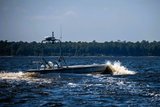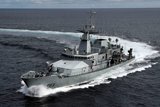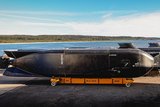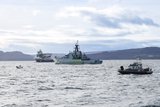HMS Queen Elizabeth reforms carrier battle group
The Royal Navy’s HMS Queen Elizabethhas reformed its carrier battle group for combined NATO/anti-submarine warfare training in the Western Atlantic.
The vessel rejoined HMS Northumberland, RFA Tideforce and the Norwegian Navy’s newest frigate, HNoMS Thor Heyerdahl, to complete this last exercise as part of its Westlant 19 deployment before returning to its homeport.
The five-week operational test phase, headed up by the Air Warfare Centre, was designed to provide end-to-end testing of British F-35 Lightning jets and the combined Royal Navy and Royal Air Force personnel who operate and support the squadrons.
Tests included mission briefs; preparation of the jets – including arming them using the ship's automated weapon handling system; launching; fighting the mission (including weapons drops) and returning to Queen Elizabeth.
At the same time, USMC F-35s flew to and from the ship, exercising their processes ahead of a detachment deploying alongside UK jets on the carrier’s maiden operational deployment in 2021.
Supporting the strike group throughout have been Merlin helicopters from 820 Naval Air Squadron based at Culdrose, providing anti-submarine protection and search and rescue capability; and 845 Naval Air Squadron transporting stores and equipment, providing rescue cover. Royal Marines from Lima Company, 42 Commando, practised combat search and rescue.
Cdre Steve Moorhouse, HMS Queen Elizabeth Commanding Officer, said: ‘This has been an extremely successful deployment for HMS Queen Elizabeth. It’s all been about increasing the complexity and tempo of our activity, building the capability of the strike group and testing ourselves in a demanding training environment with our close partners from the US Navy and Marine Corps.
‘Embarking UK F-35B Lightning for the first time and integrating them within the carrier strike group is a significant milestone and we are well set for an equally demanding 2020 and our first operational deployment in 2021.’
Related Equipment in Defence Insight
More from Naval Warfare
-
![Canadian Coast Guard’s OOSV delivery is “major milestone” in fleet modernisation]()
Canadian Coast Guard’s OOSV delivery is “major milestone” in fleet modernisation
The Polar Class 6 platform is the largest CCG science-dedicated vessel and will operate on the country’s east coast.
-
![How the Anduril-HHI autonomous ship plan fits in with the US Navy’s MASC programme]()
How the Anduril-HHI autonomous ship plan fits in with the US Navy’s MASC programme
The new modular vessel is expected to be developed for both commercial and defence use, with a heavy focus on production speed and mission flexibility.
-
![Indo Pacific 2025: Autonomous systems reigned but can the Australian Defence Force afford it?]()
Indo Pacific 2025: Autonomous systems reigned but can the Australian Defence Force afford it?
Multiple autonomous systems and technologies were on display at this year’s Indo Pacific, but questions remain over how the Australian Department of Defence will balance the books.
-
![How the UK Royal Navy is powering up its hybrid fleet to combat new threats]()
How the UK Royal Navy is powering up its hybrid fleet to combat new threats
Since it announced its move towards a new “hybrid navy” earlier this year, the force has announced a number of new uncrewed technologies in the works.
-
![US and UK to begin Trident II D5 Increment 8 in October 2026]()
US and UK to begin Trident II D5 Increment 8 in October 2026
Trident II D5 Increment 8 will involve improvements to the shipboard navigation subsystem for the US Ohio and Columbia and the UK Dreadnought and Vanguard submarine classes.






















